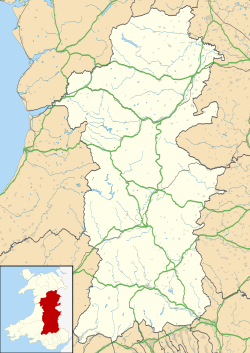Trelystan
| St Mary’s Church, Trelystan | |
|---|---|

St Mary’s Church, Trelystan
|
|
| Coordinates: 52°37′41″N 3°05′22″W / 52.628126°N 3.089548°W | |
| Location | Trelystan, Powys |
| Country | Wales |
| Denomination | Church of England |
| Architecture | |
| Heritage designation | Grade II* |
| Designated | 26 October 1953 |
| Architectural type | Church |
| Style | Timber-framed |
| Specifications | |
| Materials | Timber Framing with brick and stone outer skin |
| Administration | |
| Parish | Trelystan |
| Archdeaconry | Ludlow |
| Diocese | Hereford |
Trelystan is a remote parish and township on the border of the historic county of Montgomeryshire with Shropshire. Trelystan now forms part of the community of Forden, Leighton and Trelystan in Powys. St Mary’s Church, Trelystan is sited 900 feet up at the S end of the Long Mountain to the east of Welshpool. Trelystan was a chapel of ease within the parish of Worthen and it also served the township of Leighton. In 1854 Leighton became a separate parish and in 1874 Trelystan also became a parish. In 1933 Trelystan, Leighton and Rhos Goch parishes were combined into a larger Trelystan parish.
Trelystan is now within the Chirbury parish grouping in the Diocese of Hereford and within the Archdeaconry of Ludlow.
In some old sources the parish is also referred to as Wolston Mynd. (Walton Hill is on the eastern edge of the parish.)
There is a strong possibility that Elystan Glodrydd, who died in 1010AD, was buried at Trelystan and the Welsh placename could derive from Cappell Tref Elistan. The tradition is first mentioned in the Harleian Manuscript 1973, written by Jacob Chaloner: Elistan Glodrith, or Edelstan the renowned, borne in the Castell of Hereford, anno 933, and in the 9 yeare of Edlistan, K of Saxons, who was his godfather, was Earle of Hereford, and Lord of the countrey above Offa dich, betwene Wy and Severne, in tyme of Edelred, K of Saxons. He dyed & was buried at Cappell Tref Elistan in Causeland (i.e. Trelystan in the hundred of Cawrse).
In 1485, Long Mountain by Trelystan was the muster point of the Welsh army of Henry Tudor (King Henry VII) led by his famous military commander Sir Rhys ap Thomas. They marched from there to Bosworth Field, where they defeated King Richard III. Sir Rhys was a descendant of the Princes of Deheubarth, whose castle of Dinefwr he inherited from his father. Sir Rhys’ wife Efa (English: ‘Eva’) was a direct descendant of Elystan via his grandson Idnerth ap Cadwgan ab Elystan.
...
Wikipedia

